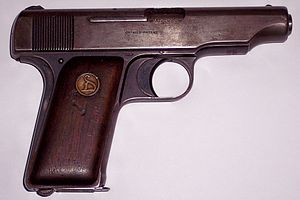Ortgies 7.65 mm Semi-Automatic Pistol
| Ortgies Semi-Automatic Pistol | |
|---|---|

Ortgies 7.65 mm semi-automatic pistol with grip safety engaged
|
|
| Type | Semi-automatic pistol |
| Place of origin |
|
| Production history | |
| Designer | Heinrich Ortgies |
| Manufacturer | Ortgies & Co. |
| Produced | 1919 – 1924 |
| Variants | 2 |
| Specifications | |
| Cartridge | |
The Ortgies 7.65 mm pistol was a hammerless semi-automatic pistol produced in Germany in the years immediately after World War I, first by its inventor Heinrich Ortgies and then by Deutsche Werke. Inexpensive, but of good quality, the pistol achieved considerable success at contemporary shooting competitions and, as an export product, was popular throughout the Americas.
The pistol was produced in 6.35 mm, 7.65 mm, and 9 mm Kurz variants. Although not expensive, at the time it was of advanced design and high quality construction with relatively few parts, well sealed against dirt. Metal components were forged or machined, and assembly in general made no use of screws, even securing the wooden grips with metal clips, although some examples do incorporate a single screw for that purpose. The hammerless action depended on a spring-loaded striker to fire the cartridge. As in early Colt and Browning pocket pistols, the Ortgies striker also operated as an ejector as the slide traveled backwards after discharge.
Unusual design features included the safety and the magazine. The safety was a lever inset into the back of the grip and, with the gun cocked, forced backward out of the grip into the "safe" position by spring tension from the firing pin upon depression of a button under the slide. Thus, engaging the safety simultaneously reduced tension on the firing pin spring. To disengage the safety, a shooter simply would squeeze the grip, pressing the lever forward and locking it flush with the back of the frame.
...
Wikipedia
